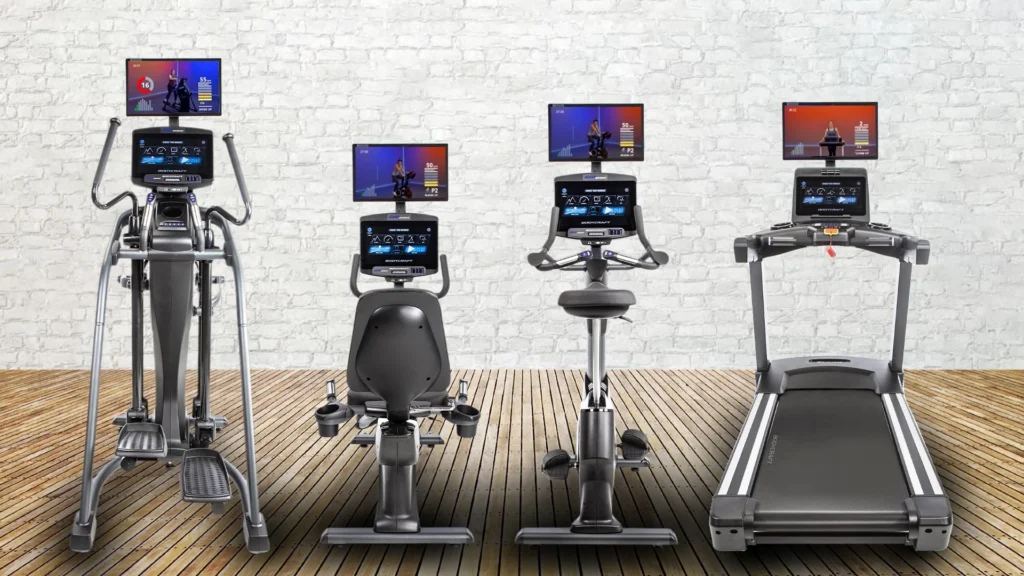Fitscope’s Plan To Revolutionize Group Fitness With On-Demand Classes
Partnership
Sponsored By Fitscope

With Fitscope Commercial, gyms can stream on-demand cardio classes to computer-connected monitors and TVs in group fitness rooms
Fitscope is on a mission to be at the forefront of the fitness industry’s digital content revolution. If the brand has its way, people will be streaming Fitscope classes on cardio machines everywhere, from their local big-box gym to their basement.
Over the last three years, Fitscope has enjoyed rapid growth in the at-home fitness market. Now the brand is looking to leverage its success with on-demand studio classes on the commercial side.
Fitscope Commercial is a subscription offering geared for gyms, hotels and other workout facilities that want an economical option to provide group fitness classes. At $50 per month per location, gyms can stream on-demand cardio classes to computer-connected monitors and TVs in group fitness rooms. The complete Fitscope library of over 1,200 classes will be available, covering every major cardio machine, including cycles, treadmills, ellipticals and rowers.
Additionally, the Fitscope app can be downloaded onto equipment with Android-based consoles. Fitscope is working with OEMs to pre-install the Fitscope app on connected cardio equipment to make it easy for gyms to set up the service and make it available for their members.
Fitscope recently announced its first OEM deal with Bodycraft, which has started shipping equipment with Bodycraft’s new Connect-22 monitor pre-installed with Fitscope. The monitor can be ordered on bikes, treadmills, ellipticals and rowers. Fitscope’s growing library of over 1,200 classes has studio workouts for all those machines and more.
“This opens up new scheduling options for gyms,” said Ed Stansfield, founder of Fitscope. “Since pricing is fixed, group on-demand classes can be scheduled at hours that don’t necessarily make sense for live instruction. Or it can be used to replace live instruction altogether for significant cost savings.”
Disrupting the Fitness Content Space
Stansfield got the idea to create Fitscope when he experienced the limitations of accessing Peloton workouts while living in Hong Kong. Since the connected fitness company’s bikes weren’t available for purchase in the East Asian country at the time, Stansfield was forced to use a generic spin bike and follow along as best he could using the Peloton app.
“I realized the value proposition that was interesting about Peloton wasn’t so much the equipment, it was the app,” he recalls.

Unlike other fitness content providers that focus on specific workout types, Fitscope sets itself apart by offering content for many types of cardio machines.
Fitscope’s online content library has grown to feature over 1,200 on-demand classes, each led by expert instructors and catering to various fitness levels and preferences. On the Fitscope app, you can find a class for pretty much any type of cardio machine, from the treadmill to more specialized devices like vertical climbers and functional trainers.
Stansfield believes a big part of what sets Fitscope apart from the litany of other fitness content providers is the scope and depth of its offerings.
“There are a lot of companies out there doing spin classes or rowing classes, but that’s just the tip of the iceberg for us,” he says. “We have categories built across all types of very niche-focused machines.”
The company also produces content for non-machine categories like yoga, stretching, strength training and core work, although its bread and butter is cardio equipment.

Fitscope currently has around 30 instructors, each of whom brings diverse and high-level fitness experience to the platform. Being situated in Los Angeles, a city with a thriving and eclectic boutique fitness scene, gives Fitscope a unique level of access to talented teachers.
The Fitscope team travels to studios across LA to take classes and hand-selects the instructors that are popular with audiences.
“We find somebody who is really popular, we do their class and then we talk to them about joining Fitscope,” Stansfield says. “So when we make an elliptical class or a vertical climber class, for example, the trainers we’ve recruited have already been doing those classes in a studio in LA. They’re already experienced on what people like, how far to push people and how to motivate people.”
A Unique App
Aside from its deep content catalog and high-quality instructors, a key aspect of Fitscope’s value proposition lies in its mobile app, which syncs to cardio equipment and heart-rate monitors using Bluetooth FTMS, the industry standard for connected fitness equipment. Users exercising on FTMS-equipped machines can see real-time data displayed on their phones or tablets while taking a class on the Fitscope app.
“If you’re doing a cycling class, you can see all the metrics from your console on the screen, like RPMs and watts,” Stansfield explains. “For a treadmill, you can see your miles per hour.”

Fitscope instructors incorporate those metrics into their sessions, giving classes an extra bit of excitement and personalization. For those without access to Bluetooth-enabled equipment, the Fitscope app displays metrics from the instructor’s machine on-screen.
Since manufacturers often send their machines to Fitscope’s studio for content production purposes, the company is uniquely positioned to be able to ensure its app pairs with as many types of cardio equipment as possible.
“We actually test on equipment from a wide range of brands and then we make tweaks to the FTMS setting to make sure that our app pairs with as many pieces of equipment as it can,” Stansfield says. “Because of that, our app ends up working with a lot more equipment than other apps that are using FTMS.”
Many Options for Consumers & Gyms
In a strategic move to gain market share and expand its reach, Fitscope recently introduced a free subscription tier to its app. With Fitscope Free, users get access to seven classes per category, or 70 classes in total, for no charge. The free classes are updated every month and feature a mix of different program lengths, types and instructors, so users get a complete picture of what Fitscope has to offer.
“Our biggest issue is getting people to try Fitscope,” Stansfield says of the decision to introduce a free tier. “Once they try it, usually they subscribe and stay subscribed for over a year. All of our retention and conversion metrics are really strong. But marketing is expensive, so we want to get Fitscope out there and make Fitscope ubiquitous across as many devices as possible.”
Fitscope’s paid subscription offers full access to the brand’s vast library of over 1,200 on-demand classes, all for a price as low as $99.99 per year for an individual user, making it a compelling value proposition for fitness enthusiasts.
In addition to its direct-to-consumer endeavors, Fitscope also has a fast-growing B2B business. The brand licenses its classes to platforms like FitnessOnDemand and even creates some white-labeled content for OEMs including Bowflex and Bodycraft. Fitscope classes consistently place in FitnessOnDemand’s monthly Top 10 rankings, so the partnership has served well to increase brand awareness.
Stansfield doesn’t see Fitscope’s different business models as competing with each other. The important thing, he believes, is getting the Fitscope name out there, whether that’s directly to consumers through the company’s app, on cardio machines in gyms, on on-demand platforms, or through white-label partnerships.
“This is the way the television industry has worked for years,” says Stansfield, recalling his former days as a TV executive. “Some of the biggest shows on Netflix have actually been produced at Warner Brothers Studio. Warner Brothers has their own HBO Max app, yet they’re still happy to license some of their content to Netflix and produce content for them. I think that’s how the fitness ecosystem will ultimately evolve.”



